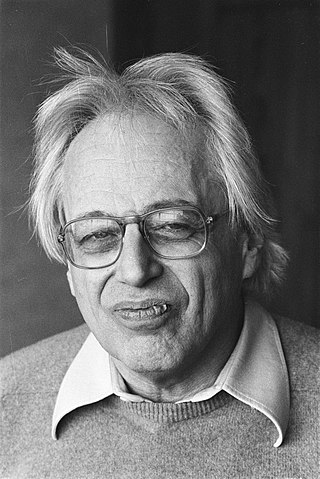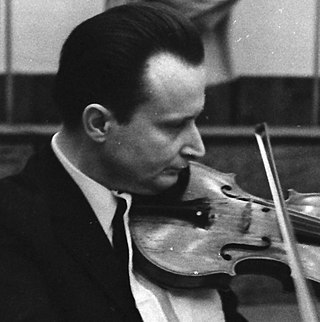Related Research Articles
A concerto is, from the late Baroque era, mostly understood as an instrumental composition, written for one or more soloists accompanied by an orchestra or other ensemble. The typical three-movement structure, a slow movement preceded and followed by fast movements, became a standard from the early 18th century.

György Sándor Ligeti was a Hungarian-Austrian composer of contemporary classical music. He has been described as "one of the most important avant-garde composers in the latter half of the twentieth century" and "one of the most innovative and influential among progressive figures of his time".

György Kurtág is a Hungarian composer of contemporary classical music and pianist. According to Grove Music Online, with a style that draws on "Bartók, Webern and, to a lesser extent, Stravinsky, his work is characterized by compression in scale and forces, and by a particular immediacy of expression". In 2023 he was described as "one of the last living links to the defining postwar composers of the European avant-garde".

Esa-Pekka Salonen is a Finnish conductor and composer. He was the music director of the San Francisco Symphony and conductor laureate of the Los Angeles Philharmonic, Philharmonia Orchestra in London and the Swedish Radio Symphony Orchestra. He resigned from the San Francisco Symphony in 2024.

Pierre-Laurent Aimard is a French pianist.
Unsuk Chin is a South Korean composer of contemporary classical music, who is based in Berlin, Germany. Chin was a self-taught pianist from a young age and studied composition at Seoul National University as well as with György Ligeti at the Hochschule für Musik und Theater Hamburg.

The Concerto for Piano and Orchestra by György Ligeti is a five-movement piano concerto. Ligeti wrote:
I present my artistic credo in the Piano Concerto: I demonstrate my independence from criteria of the traditional avantgarde, as well as the fashionable postmodernism. Musical illusions which I consider to be also so important are not a goal in itself for me, but a foundation for my aesthetical attitude. I prefer musical forms which have a more object-like than processual character. Music as "frozen" time, as an object in imaginary space evoked by music in our imagination, as a creation which really develops in time, but in imagination it exists simultaneously in all its moments. The spell of time, the enduring its passing by, closing it in a moment of the present is my main intention as a composer.
Chen Yi is a Chinese-American composer of contemporary classical music and violinist. She was the first Chinese woman to receive a Master of Arts (M.A.) in music composition from the Central Conservatory of Music in Beijing. Chen was a finalist for the 2006 Pulitzer Prize for Music for her composition Si Ji, and has received awards from the Koussevistky Music Foundation and American Academy of Arts and Letters, as well as fellowships from the Guggenheim Foundation and the National Endowment for the Arts. In 2010, she was awarded an Honorary Doctorate from The New School and in 2012, she was awarded the Brock Commission from the American Choral Directors Association. She was elected to the American Academy of Arts and Letters in 2019.

Hormoz Farhat was a Persian-American composer and ethnomusicologist who spent much of his career in Dublin, Ireland. An emeritus professor of music, he was a fellow of Trinity College, Dublin. Described by the Irish Times as a "gifted and distinctive composer of contemporary classical music," his compositions include orchestral, concertante, piano and choral music, as well string quartets and chamber works. He also wrote numerous film scores, including that of Dariush Mehrjui's 1969 film The Cow. However, his musicological research dominates his legacy; his writings on the music of Iran—a country which he insisted be called 'Persia'—were pivotal in ethnomusicology, particularly his acclaimed 1990 study The Dastgah Concept in Persian Music.
Junsang Bahk is a celebrated Korean composer, also active in Austria.

The Concerto for Violin and Orchestra by György Ligeti is a violin concerto written for and dedicated to the violinist Saschko Gawriloff. A performance of the work lasts about 28 minutes.

Mari Takano is a Japanese composer, pianist, essayist, and teacher. Takano's work, and musical voice, has been recognized as among the most distinctive to be found amid Japanese composers of the "post-Takemitsu generation".

György Ligeti composed his Viola Sonata between 1991 and 1994. It is a sonata for viola solo in six movements, and Ligeti composed it in various phases, parallel with his Violin Concerto, and his piano études. The composer was inspired to write a viola sonata after hearing Tabea Zimmermann playing on the radio, then began writing various movements. The second movement Loop, was premiered by Garth Knox, while Facsar was premiered in 1993 by Jürg Dahler. The two movements were conceived as part of a complete work and they became the second and third movements of Ligeti's Viola Sonata.
Detlev Müller-Siemens is a German composer and conductor.

Dénes Kovács was a Hungarian classical violinist and academic teacher, described as "pre-eminent among Hungarian violinists". He won the Carl Flesch International Violin Competition in 1955. In his career as a soloist and recording artist, he premiered and recorded the works of 20th-century Hungarian composers, and was also noted for his recordings of Bartók and Beethoven. From 1967 to 1980, he headed the Franz Liszt Academy of Music in Budapest, Hungary's principal music college. He received many national awards including the Kossuth Prize (1963).
Karen Anne Tarlow is an American composer and music educator who has composed multi-media pieces and many choral works based on Hebrew texts.
Friederike Schwarz was a Czech composer, educator, pianist and writer. She, together with her sister, committed suicide during the Prague uprising. She sometimes published under the pseudonym rz.
Ann Elizabeth Sandifur is an American business woman, composer, teacher and writer. She has produced several electronic and multimedia works.
Patsy Rogers is an American composer and teacher who has won several awards and commissions. She is active in the International Alliance for Women in Music (IAWM).
References
- 1 2 3 4 5 6 7 Cohen, Aaron I. (1987). International encyclopedia of women composers. 2: Sai - Zyb, Appendices (2. ed., revised and enl ed.). New York: Books & Music. p. 612. ISBN 978-0-9617485-1-7.
- 1 2 3 4 "Other Musicians". Melody of China. 2019-01-24. Retrieved 2023-08-13.
- ↑ Stewart-Green, Miriam (1980). Women composers: A checklist of works for the solo voice. A reference publication in women's studies. Boston, Mass: Hall. p. 137. ISBN 978-0-8161-8498-9.
- ↑ Stern, Susan (1978). Women composers: a handbook. Metuchen London: the Scarecrow press. p. 146. ISBN 978-0-8108-1138-6.
- ↑ Shirai, Noboru (2001). Tule Lake: An Issei Memoir. Muteki Press. ISBN 978-0-9716108-0-4.
- ↑ Samson, Valerie Brooks (2000). The Modern Chamber Concerto as Genre: György Ligeti's Chamber Concerto (1969-1970) And, Chamber Concerto (with Original Composition). University Microfilms Incorporated.
- ↑ Pfitzinger, Scott (2017-03-01). Composer Genealogies: A Compendium of Composers, Their Teachers, and Their Students. Rowman & Littlefield. p. 471. ISBN 978-1-4422-7225-5.
- 1 2 3 Anderson, Ruth; Anderson, E. Ruth (1976). Contemporary American composers: a biographical dictionary. Boston, Mass: Hall. p. 379. ISBN 978-0-8161-1117-6.
- ↑ Ear Magazine. New Wilderness Foundation. 1977.
- ↑ Archives, L. A. Times (1985-12-19). "Graduate Student Gets Grant". Los Angeles Times. Retrieved 2023-08-13.
- ↑ China Exchange News. Committee on Scholarly Communication with the People's Republic of China. 1986.
- ↑ Boenke, H. Alais (1988-10-19). Flute Music by Women Composers: An Annotated Catalog. Bloomsbury Publishing USA. ISBN 978-0-313-36831-8.
- ↑ International League of Women Composers Newsletter. The League. 1986.
- ↑ Cum Notis Variorum: The Newsletter of the Music Library, University of California, Berkeley. The Library. 1989. p. 19.
- ↑ The Composer. Composers' Autograph Publications. 1978. p. 28.
- ↑ rilm (2021-10-14). "The Philippine drug war, a hip-hop response, and an annotated bibliography on music and protest". Bibliolore. Retrieved 2023-08-13.
- ↑ China Exchange News. Committee on Scholarly Communication with the People's Republic of China. 1986.